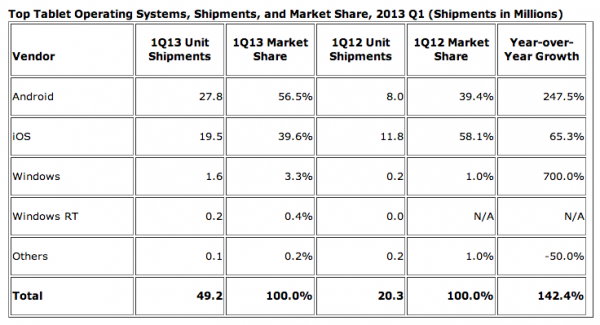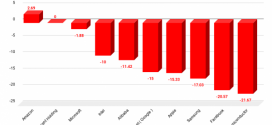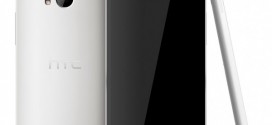IDC has reported its Q1 2013 numbers, and it looks like the Android tablet market share dominates for the first time since the iPad came out. The iPad market share dropped 19% compared to last quarter, and the Windows tablet market share got only 3.7% in total (Windows 8+Windows RT).
iPad Share of Tablet Market Was Destined to Shrink
It may not seem like a big deal now, but I remember when the idea that the Apple iPad is the “iPod of tablets” (meaning it will always maintain 80%+ market share, just like the iPod in the music player market) was quite popular, because some tech writers wrote a few articles with some pretty convincing (at least on the surface) arguments why that may happen.
But they failed to take into account two things. One was that the iPod was mainly a US product, helped by Apple‘s retail stores, which were everywhere in US, but very rare in other countries. And two, the music player market was never about the “ecosystem”.
So even if Apple completely dominated the US market, there has always been a very high chance Android tablets would still dominate globally, where Apple, while a popular brand even globally at this point, still has a relatively small presence in stores. They also don’t benefit from all the carriers’ stores, like they do with the iPhone, although some of them do carry the iPad, too.
The second factor, the ecosystem, plays a big role this time around. Back when the iPod was launched, the manufacturers didn’t unify under a strong second ecosystem. In smartphones they did, which meant it was only a matter of time before they passed past Apple in worldwide tablet market share, just like they did in smartphones.
Android Tablet Market Share Smaller than It Should Be
For the most part, this growth is despite Google in many ways. If Google would’ve been a lot more serious about tablets from day one, and not rush an unfinished Honeycomb OS to market, with a very expensive $800 tablet (Motorola Xoom), and if they would’ve released the SDK months earlier, so people can get some apps on those tablets, Android tablets could’ve taken off a lot earlier.
In the first year of Android tablets (and second year for iPad), the tablet sales were a complete bust. It wasn’t really until Amazon’s Kindle Fire, that tried to brute force its way into the market through a very affordable price, followed by the Google Nexus 7 a year later, until Android tablets really started growing.
Google also left a huge window for Microsoft to come out with Windows 8. But fortunately for them, Windows 8 and Windows RT don’t seem like very lean operating systems for tablets, which is why they need significantly more expensive hardware to run on.
So I do think Android was supposed to dominate in tablet market share, too, just like it did in smartphones, because it’s an open source and free OS that every manufacturer has adopted. But Google actually slowed down the growth of Android tablets, by not taking them seriously early on, and (still) not caring too much about optimized Android tablet applications.
Tablet Market Forecast 2013
I expect the Android tablet market share to reach similar levels with the market share in smartphones, so around 70% or so, and it should happen this year, after Google launches a new next-gen Nexus 7 tablet, and others like HP and Acer become more serious about Android tablets. While the HP tablet market share is almost inexistent right now, I expect them to have quite a few sales once they make a quality tablet (hasn’t happened yet) that they can push through their huge sales channels. However, in the Android tablet market, Google and Samsung are likely to remain the dominant players.
 TechDomino
TechDomino



